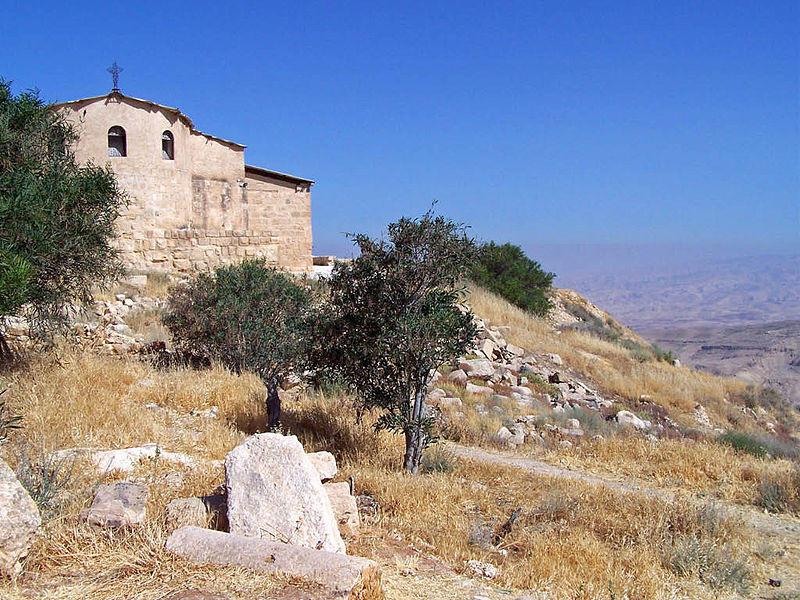22 Apr. Moses dies at Mount Nebo
“Then Moses climbed Mount Nebo from the plains of Moab to the top of Mount Pisgah, across from Jericho. From there the LORD showed him all the land from Gilead to Dan, all of Naphtali and the lands of Ephraim and Manasseh, all the land of Judah as far as the Mediterranean Sea, as well as the southern desert and the whole Valley of Jericho up to Zoar…”
“Then the LORD said to Moses, ‘This is the land I promised to Abraham, Isaac and Jacob when I said to them, ”I will give this land to your descendants.” I have let you look at it, Moses, but you will not cross over there.’”
“Then Moses, the servant of the LORD, died there in Moab, as the LORD had said. He buried Moses in Moab in the valley opposite Beth Peor, but even today no one knows where his grave is.”
“Moses was 120 years old when he died. His eyes were not weak, and he was still strong. The Israelites cried for Moses for 30 days, staying in the plains of Moab until the time of sadness was over.”
“Joshua son of Nun was then filled with wisdom, because Moses had put his hands on him. So the Israelites listened to Joshua, and they did what the LORD had commanded Moses.”
“There has never been another prophet in Israel like Moses. The LORD knew Moses face to face and sent him to do signs and miracles in Egypt – to the king, to all his officers and to the whole land of Egypt. Moses had great power, and he did great and wonderful things for all the Israelites to see.”
(Deuteronomy 34:1-12)

The last chapter of the Book of Deuteronomy tells us that Moses climbed Mt Nebo from the Plains of Moab (see the map on 13 April) to the top of the ‘pisgah’ (or viewpoint) east of Jericho where the LORD showed him all the ‘promised land’:
the territory of Gilead as far north as Dan
the entire territory of Naphtali
the territory of Ephraim and Manassah
the territory of Judah west to the Mediterranean Sea
and the Jordan valley from Zoar to Jericho (the ‘City of Palms’).
Having caught a glimpse of the land God promised the Israelites through his ancestors Abraham, Isaac and Jacob, Moses died on Mt Nebo in c.1406BC.
Moses was buried at the foot of Mt Nebo on the Plains of Moab opposite the town of Beth Peor (‘Temple of Peor’), but “to this day” no one knows exactly where Moses was buried (see Deuteronomy 34:6).
Joshua - Moses’ assistant who had been appointed in his place (see Numbers 27:12-23) - was now filled with wisdom by God, and the Israelites began to follow his instructions.
At 2680 feet / 817 m above sea level, Mt Nebo is the highest summit in the northern Abarim Mountains, on the eastern side of the Dead Sea overlooking the Plains of Moab to the south-east of Jericho (see Numbers 27:12). Moses climbed Mt Nebo so he could look out across the whole of the ‘promised land’ of Canaan just before he died.
He was then buried in an unmarked cave at the foot of the mountain. Some believe the apocryphal story that the ‘lost’ Ark of the Covenant was also hidden here by the prophet Jeremiah just before King Nebuchadnezzar of Babylon sacked Jerusalem in 587 BC (see 2 Maccabees 2:4-8).
Today, visitors to Mt Nebo, in Jordan, can look out from the pisgah (the summit viewpoint) near the Brazen Serpent monument at Syagha, 6 miles / 10 km west of the old Roman town of Madaba, westwards across the Dead Sea and beyond towards Jerusalem and Bethlehem.
They can enter the Franciscan Church of Mt Nebo, built on top of the 4 - 7th century AD remains of a series of early Christian churches (and a Byzantine monastery) built to commemorate the death and burial of Moses. Inside the church, a beautifully preserved mosaic floor from the old baptistry, dating from 531AD, shows pastoral and hunting scenes, with remarkably lifelike images of savanna wildlife including a zebra and an ostrich.
The photo (by Tom Neys) shows the chapel on the summit of Mt Nebo.
You can see a photo of the 6th century mosaic in the Church of Mt Nebo (by Jerzy Strzelecki) @ https://www.thebiblejourney.org/biblejourney2/26-the-journey-continues-from-sinai-to-moab/moses-dies-at-mount-nebo/
